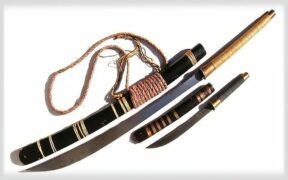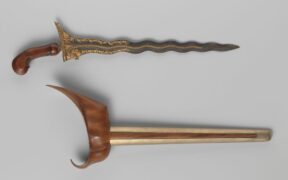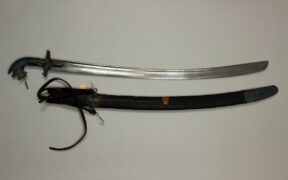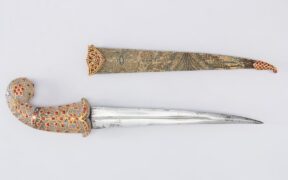Our content features commercial links to our products, committed to transparent, unbiased, and informed editorial recommendations. Learn More
Uncovering Krabi Krabong: Thailand’s Weapon-Based Martial Art
NO AI USED This Article has been written and edited by our team with no help of the AI
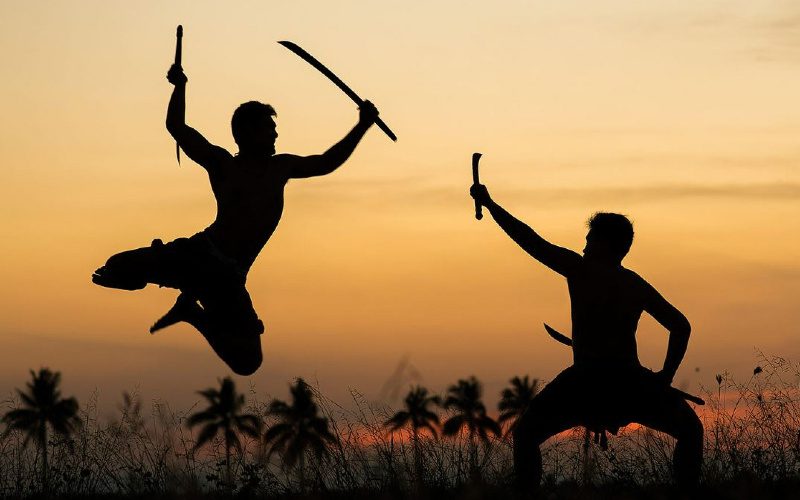
Humans have never been equipped with fangs, claws, or powerful enough bodies to defend themselves against predators. Because of this, martial arts developed out of the need for survival against both animals and man, beginning sometime during the Bronze Age.
The weapon-based martial art that came out of a need for self-defense in ancient Thailand and is still practiced today is known as Krabi Krabong. However, this Thai martial art has yet to reach high popularity since it does see international or regional competitions outside of Thailand. Still, it was used in the country’s military forces.
In this article, we will shed some light on the fierce yet elegant sport of Krabi Krabong and uncover everything you need to know. We will go over the weapons used, where the sport stands today and the puzzle of its origins.
What is Krabi Krabong?
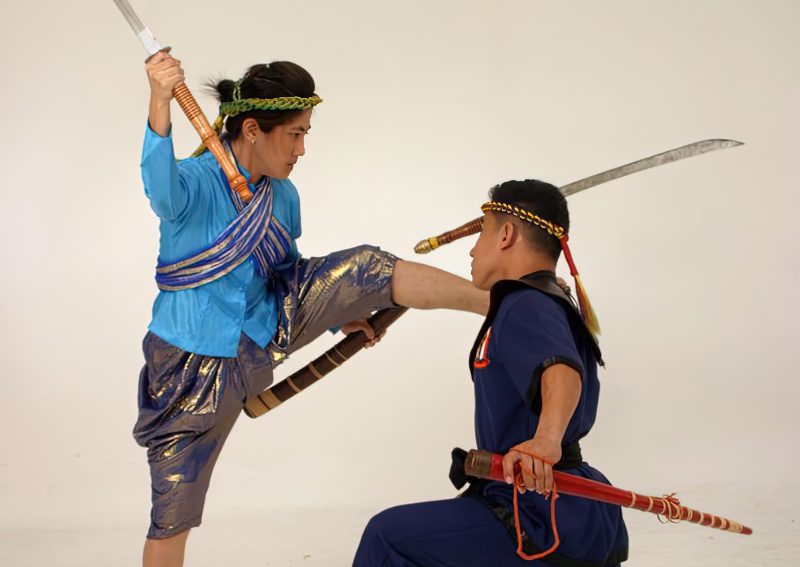
The roots of Krabi Krabong are traced to Thailand, and its meaning translates to the words sword and staff. It is practiced as a martial art, a sport, a form of entertainment, and a method of self-defense. Traditional Thai Arms use props that look like swords, spears, halberds, and staffs made out of wood, metal, and animal hide. Although used less frequently, a shield or short elbow bow are also examples of self-defense weapons.
Krabi Krabong involves duels between two people which take place within a circle and are not limited by time. During the fight, participants use two weapons simultaneously, one in each hand. Some weapons are swords and staffs for attacks, and others, like clubs and shields, are for self-defense.
Because of its popularity and the extent to which it was employed in the military, Krabi Krabong heavily influenced traditional Thai weaponry used in combat. Some of these are still used in the practice of Krabi Krabong today.
Use of Krabi Krabong Today
Krabi Krabong today is a very interesting martial art used throughout Thailand but is also used in some training schools around the globe. It is a dignified sport that includes using swords, staffs, shields, and clubs, along with a knowledge of boxing and kicking. Sparring is commonly used during combat and duels. Interestingly, many dances, like the Brahma or Weapon dance, can be incorporated into the sport.
Some may view Krabi Krabong as a martial art that uses only sword fighting, but many other elements are wielded. Muay Boran, a form of unarmed combat, is sometimes seen. However, the wide use and variety of weapons help users become attuned to using them as an extension of themselves. By strengthening the bond with every weapon, the recipient may enhance their reflexes, see more clearly, move faster, and judge distance and timing more accurately.
There are many high-quality Krabi Krabong schools that you can attend around the world as well as in the birthplace of Krabi Krabong – Thailand. The most popular ones are Sangha School in Chiangh Mai, Thailand, The Sitsiam Camp in Manchester, England, and Tiger Muay Thai in Phuket, Thailand.
Benefits of Training
Training with a Krabi Krabong school with an experienced ajarn, the Thai term for teacher, will give you many benefits. The biggest benefit is learning how to properly defend yourself both with and without a melee weapon.
In addition to self-defense, you’ll learn patience and discipline and find yourself in better overall physical health. But one of the most important benefits of training in Krabi Krabong is Wai Khru, which expresses gratitude toward all human beings, cultures, and ancestors.
Training Weapons Used in Krabi Krabong
Krabi Krabong has a wide variety of fighting styles because of its many weapons. These weapons are mostly made out of wood or rattan, materials used for sparring when combined with protective outfits.
Almost all of the Thai weapons used in melee scenarios are included but becoming a master, and a black belt requires the knowledge of kickboxing as well as using double swords for sword fighting.
Krabi or Daab

The Dha, Daab or Krabi is a knife-looking sword from Southeast Asia that curves gently and has a single edge like the Japanese Katana. Thai Dhas also have a round gross-grip section and no guard. The blade can either be upward or downward when used.
The tip of the sword can also appear in a variety of ways. Sometimes it is up-swept; other times, it is down-swept. Some are squared-off, and others appear spear-like.
Some historians believe the Dha sword may have its roots in China, where the word for a knife is Dao. It could have been used in the Himalayas and then spread into Southeast Asia or possibly even brought by the migrating Thai people in the southern provinces of China.
This Thai sword is used as a one-handed weapon in Krabi Krabong since it is very light and easy to hold in the way it is carried just under the armpit, held with a rope.
- Type – Sword
- Blade – curved, single-edged
- Guard – /
- Handle – curved, one-handed use
- Length & Weight – 20 inches (50 cm) & 1.1 lbs (500 grams)
Daab Song Mue
The Daab Song Mue is the same as the Daab sword but can be slightly smaller and lighter, featuring a very small guard at times. The Daab Song Mue can also be used as a duel-wielding weapon. This training instrument is one of the most popular in Krabi Krabong since it is a tremendous joy to watch a person dual-wielding swords and using their entire body to move around in lighting quick, graceful motions.
Krabong
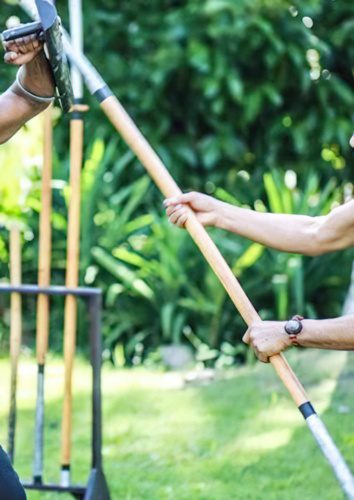
The Krabong is a stick or staff which tends to be roughly the same height as the person using it and takes the form of a long straight staff for sparring fights today. Because of its length, the Krabong can be used two-handed or with a shield or Krabi in the other hand.
They are often made of wood or ebony and are not often used in the present-day Krabi Krabong. Because of this, they are commonly confused with the long pole (Phlong), also used as a weapon in Krabi Krabong. The staffs are the biggest weapons of the Krabi Krabong arsenal, and their biggest advantage and disadvantage is their length.
- Type – Staff
- Handle – straight, long, two-handed
- Length & Weight – 47 to 70 inches (1.3 to 1.8 meters) & 0.6 to 1.3 lbs (300 to 600 grams)
Phlong
The Phlong, a staff used in dueling, is usually held with two hands since it is slightly longer than the Krabong. The four-direction Brahma dances experienced Krabi Krabong users can perform with the Phlong aren’t always used in fighting. They are practiced to lift morale and remind watchers of the four principles of Brahmavihara – empathetic joy, serenity, compassion, and benevolence.
Ngao
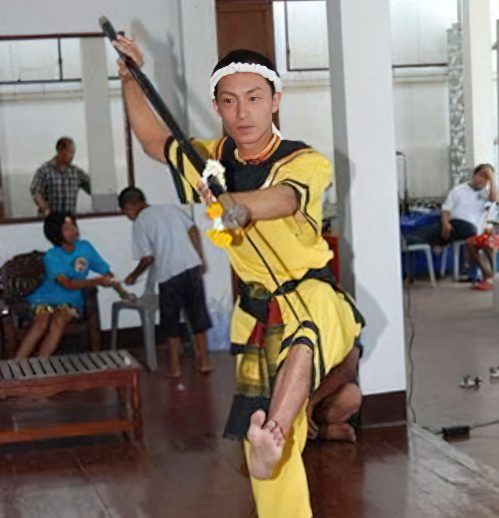
The Ngao, a pole-like weapon with a blade attached to its end, was used during the 18th century in Thailand. The blade is sometimes in the shape of a knife, a trident, or a sword and is often curved. The Ngao is used for multiple purposes, including stabbing, cutting, and disarming an opponent.
The Ngao was traditionally used in early mounted battlefield tactics in Thailand as this kind of polearm was commonly used by elephant warriors. The weapon often had a hook between the blade and the shaft, which was used to instruct the animal.
Elephants were important in early Thai military tactics, acting as horses did for European cultures. While the ngao is no longer used in mounted combat, it is still used in Krabi Krabong today.
- Type – staff/polearm
- Handle – straight, long, two-handed
- Length & Weight – 70 inches (1.8 meters) & 1.1 to 2.2 lbs (0.5 to 1 kg)
Mai Sok San
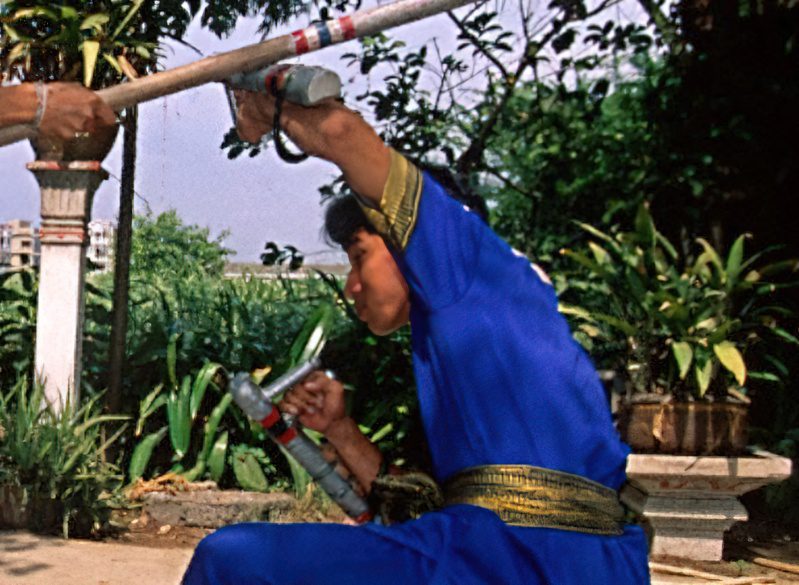
The Krabi Krabong Mai Sok, also known as the Mai Sok San, is another amazing traditional Thai weapon. It was used for offense and defense, much like the Japanese tonfa. The forearms of the user are strapped with two pieces of rectangular wood with grips and are highly utilized in defending against strikes both from a polearm or a sword.
The Mai Sok San is one of the easier weapons to maneuver. While defending against incoming attacks, the hardwood on the hands can be used in offense by experienced martial artists by combining some Thai boxing or some effective and quick leg kicks.
- Type – Hand clubs
- Handle – straight
- Length & Weight – 12 to 16 inches (30 to 40 cm) & 0.9 to 1.5 lbs (400 to 700 grams)
Kaen, Daeng, and Lob
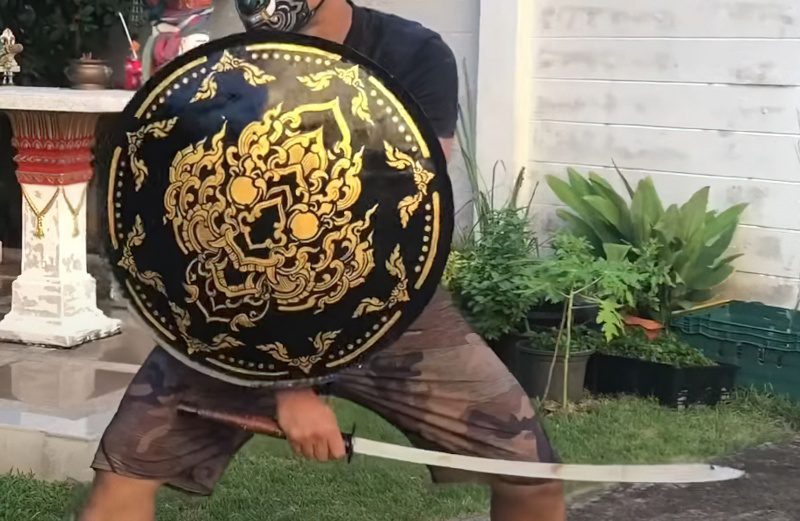
The biggest defensive weapons in Krabi Krabong are the three types of shields, the Kaen, the Daeng, and the Lob. They are used when combined with other types of offensive weapons like the sword or the spear and are made from either wood, leather, or metal.
The Kaen is a shield used for offense and defense because of its sharp edges.
The Daeng is a long shield that protects the range from the elbow to the user’s knees.
The Lob shield is very long and can cover all of the user’s body.
- Type – shield
- Shapes – round, rectangular
- Length & Weight – 20 to 48 inches (50 to 120 cm) & 1.1 to 4.4 lbs (0.5 to 2 kg)
Kris

The kris is an asymmetrical dagger that often has carvings from events in South Asian historical or mythological elements on the blade, which makes it distinct. Thought to have origins in Japanese culture, the kris was incorporated into the Indonesian martial art Pencak Silat, an early precursor of Krabi Krabong.
Because of the maritime trade network between the regions, use of the weapon spread as far as Thailand, Malaysia, Singapore, and the Southern Philippines. The kris was commonly used by warriors and commoners as a form of personal protection. They were also seen as spiritual objects that held magical powers.
Although today they aren’t part of the Krabi Krabong, the kris is still an intriguing weapon that was once part of this very interesting martial art.
- Type – Knife/Dagger
- Blade – wavy design
- Guard – /
- Handle – curved, small, one-handed
- Length & Weight – 15 to 30 inches (38 to 76 cm) & 1 to 2 lbs (450 to 900 grams)
History & Origins of Krabi Krabong
The history of the Krabi Krabong is very puzzling and confusing, especially its origins. There are generally two theories about the origins of this mysterious martial art.
Ancient Warfare Theory
The largest school of thought believed is that Krabi Krabong comes from ancient times because of the many fighting styles, such as the Chinese Monkey Style, which has swift movements of dangerous nature to confuse and disorientate the enemies before striking them.
This theory says that the ancient people of Siam combined many different styles of Pahuyuth, an ancient martial art of the common and free people of South Asia. A combination of the neighboring martial art influences over time have made the Krabi Krabong what it is today.
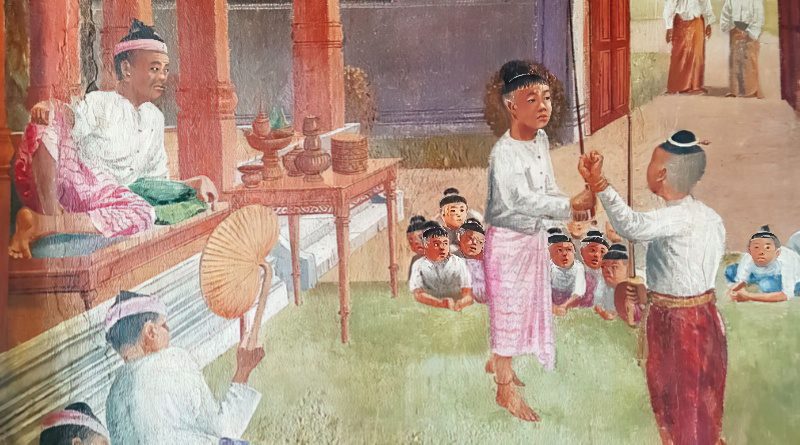
This same theory brought us to the 18th century when the Burmese attacked the Thai city of Ayutthaya. With the execution of King Tak Sin, the free warriors of Thailand were hiding in fear of persecution. Sadly, all scripts of this martial art were destroyed, nearly erasing it from history.
That is until the early 19th century, under the reign of King Rama II, when a new fighting and sparring sword style developed; the Krabi Krabong. For a century, this fencing art, which had the Krabi sword being a European-style sabre with a knuckle guard and a straight blade, was used only by the royal family in the siamese lands.
Because it was only linked with the royals and nobility, Krabi Krabong lacked the popularity and became even more obsolete at the beginning of the 20th century. Thankfully, Professor Nak Thephasadin Na Ayudhya, who has had a lifelong passion for the sport, has committed his life to preserving the tradition of Krabi Krabong.
When he took over as headmaster of the Central Physical Education Institute in Bankok 1935, Professor Na Ayudhya established the first-ever school-based Krabi-Krabong class. The Thai Ministry of Education later added the discipline to the national curriculum for physical education in 1975.
Sport & Fencing Theory
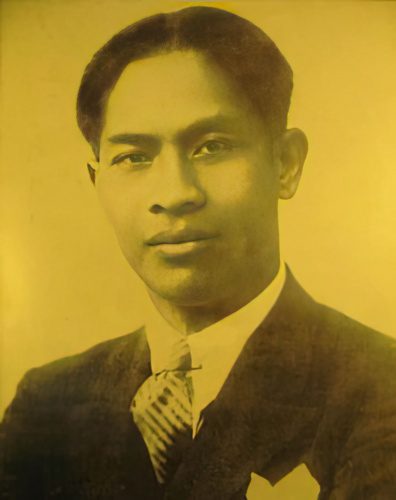
Another school of thought is that Krabi Krabong never was an ancient art. Instead, some historians believed it was developed only for fencing and as a sport, as can be seen in the writing of Ajarn Foong Koedkau, Vice Professor of a university in Bangkok and a disciple and student of Nak Thephasadin himself.
Foong Koedkau clearly states that Krabi Krabong is a fencing, not a war art, and has never seen its connection to any ancient martial art or warfare.
“I can say with all my heart and without shame that Krabi Krabong is a real sport from Thailand.”
Professor Koedkau’s theory states that Krabi Krabong was never put to use in a war, as it was never intended for use in real-life large or small-scale battles past or present.
Conclusion
Unfortunately, very few individuals in the present period had an opportunity to experience the full beauty of Krabi-Krabong, a Thai martial art with striking skills and depth of meaning that are unequaled. But the government of Thailand has taken steps to bring this martial art back to the forefront, and many young Thai people are now inspired by it.
